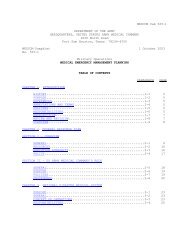(MCD) Guidelines
(MCD) Guidelines
(MCD) Guidelines
Create successful ePaper yourself
Turn your PDF publications into a flip-book with our unique Google optimized e-Paper software.
<strong>Guidelines</strong> for Military Mass Casualty Decontamination Operations<br />
During a Domestic HAZMAT/Weapon of Mass Destruction Incident<br />
Level A protection should be used when:<br />
• The hazardous substance has been identified and requires the highest level of<br />
protection for skin, eyes, and the respiratory system. Use of Level A is based on<br />
the measured (or potential for) high concentration of atmospheric vapors, gases,<br />
or particulates. Level A is also used if the site operations and work functions<br />
involve a high potential for splash, immersion, or exposure to unexpected vapors,<br />
gases, or particulates of materials. These substances are harmful to skin or<br />
capable of being absorbed through the skin.<br />
• Substances with a high degree of hazard to the skin are known or suspected to be<br />
present. Skin contact is possible.<br />
• Operations must be conducted in confined, poorly ventilated areas. Also, the<br />
conditions requiring Level A have not yet been determined.<br />
• Casualties indicate a harmful substance of some type. The level of hazard is<br />
unknown.<br />
Level B protection should be used when:<br />
• The type and atmospheric concentration of substances have been identified. The<br />
substances require a high level of respiratory protection but less skin protection.<br />
• The atmosphere contains less than 19.5% oxygen.<br />
• A direct-reading organic vapor detection instrument indicates incompletely<br />
identified vapors or gases are present. However, vapors and gases are not<br />
suspected of containing high levels of chemicals harmful to skin or capable of<br />
being absorbed through the skin.<br />
• An unknown environment is encountered. Level B is the minimum required level<br />
of protection. 15,45,46<br />
• NOTE: Level B is used with atmospheres with immediately dangerous to life and<br />
health (IDLH) concentrations of specific substances that present severe inhalation<br />
hazards. The substances do not represent a severe skin hazard or do not meet<br />
the criteria for using air-purifying respirators. Among other references, the IDLH<br />
level can be found in the NIOSH Pocket Guide 43 or in the MSDS for the product, if<br />
available.<br />
Level C protection should be used when:<br />
• The atmospheric contaminants, liquid splashes, or other direct contact will not<br />
adversely affect or be absorbed through any exposed skin.<br />
• The types of air contaminants have been identified, concentrations measured, and<br />
an air-purifying respirator is available that can remove the contaminants.<br />
• All criteria for the use of air-purifying respirators are met.<br />
• NOTE: MOPP Level 4 is the closest equivalent to an OSHA Level C ensemble.<br />
However, it does not meet OSHA Level C requirements because the suit is not<br />
splash-protective.<br />
Level D protection should be used when:<br />
• The atmosphere contains no known hazard.<br />
• Work functions preclude splashes, immersion, or the potential for unexpected<br />
inhalation of or contact with hazardous levels of any chemicals.<br />
18 Original



